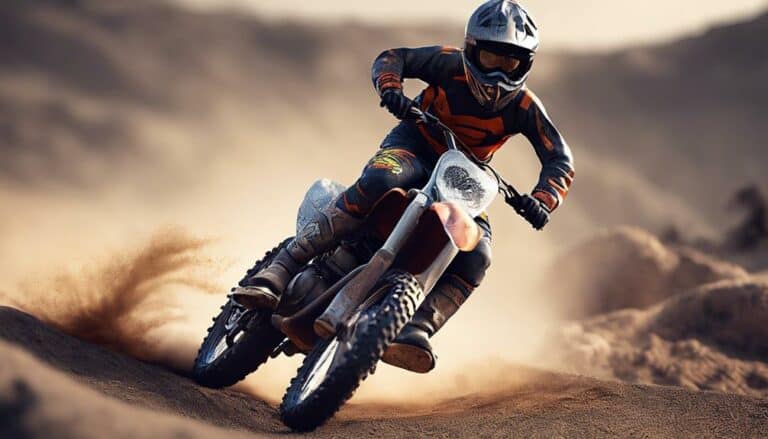When it comes to controlling speed on a dirt bike, think of it as orchestrating a symphony of precision and finesse. From the gentle dance of throttle control to the artful balance of braking techniques, there are multiple avenues for you to explore.
Understanding the nuances of each method can enhance your riding experience and push your skills to new heights. So, ready to reveal the secrets that will take your dirt biking prowess to the next level?
Key Takeaways
- Distribute weight, use front brake, and lean back for controlled speed management.
- Master front and rear brakes for optimal stopping power and stability.
- Practice trail braking for precise cornering and speed adjustment.
- Implement engine braking and controlled slowing techniques for efficient speed control.
Braking Techniques for Dirt Biking
Mastering the art of braking is essential for controlling speed effectively while dirt biking. As you navigate the rugged terrain, understanding how to brake properly can make all the difference in your ride. When approaching a turn or needing to slow down, remember to distribute your weight onto the front of the bike. By doing this, you increase the traction on the front tire, allowing for better control and stability.
Utilize both the front brake and rear tire to apply even pressure, preventing skidding and maintaining balance. Your body position plays a vital role in efficient braking; lean slightly back to prevent flipping over while still keeping your weight forward. Practice controlled braking to smoothly adjust your speed, ensuring a safe and exhilarating ride every time.
Mastering Front and Rear Brakes
To achieve ideal control over your dirt bike, it's important to understand and effectively utilize both the front and rear brakes. The front brake is a powerful tool, providing around 70% of the stopping power on a dirt bike. Learning to modulate the front brake is essential for controlled deceleration and precise cornering. On the other hand, mastering the rear brake is vital for maintaining stability and preventing the rear wheel from sliding out.
Balancing the use of both brakes is key to efficient speed control and stopping. By practicing different braking techniques on various terrains, you can enhance your skills and build confidence in handling your dirt bike. Remember, the front brake is your primary weapon for swift stops and tight turns, while the rear brake adds stability and control to your riding experience. Embrace the challenge of mastering both brakes, and you'll discover a whole new level of performance and freedom on your dirt bike.
Understanding Trail Braking
Embrace the technique of trail braking as a dynamic method to control speed and enhance stability while riding corners on your dirt bike. Trail braking is a skillful maneuver used by experienced riders during trail riding and dirt biking. By continuing to apply the brakes as you lean into the corner, trail braking allows you to modulate speed and maintain control throughout the turn. This method optimizes your corner entry speed, giving you the edge when handling tricky bends and curves.
To effectively trail brake, you must practice finding the right balance between braking, leaning, and throttle control. Gradually releasing the brakes as you progress through the turn is key to mastering this technique. Advanced riders utilize trail braking to carry more speed through corners, ultimately improving their lap times and overall performance on the track.
Utilizing Engine Braking
Discover the art of harnessing engine braking as a powerful technique to enhance speed control and stability on your dirt bike. Engine braking is a skill that can greatly improve your riding efficiency by utilizing the bike's natural resistance to slow down.
Here's how you can make the most out of engine braking:
- Engage the Rear Wheel: When you downshift and release the throttle, the engine's compression engages the rear wheel, providing a smooth deceleration without solely relying on the brakes.
- Balancing Front and Rear: By using a combination of front and rear brakes along with engine braking, you can achieve the best speed control on descents and tricky terrains while maintaining stability.
- Enhancing Riding Efficiency: Properly utilizing engine braking not only helps in controlling speed but also contributes to the longevity of your brakes, ultimately improving your overall riding efficiency and experience. Mastering this technique will give you a sense of freedom and control over your dirt bike like never before.
Practicing Controlled Slowing
Practicing controlled slowing demands finesse and precision, requiring riders to master the art of smooth deceleration through strategic brake application. To excel at this skill, focus on gradually applying the rear brake to reduce speed smoothly and avoid skidding.
Additionally, remember to utilize engine braking by downshifting to a lower gear, allowing the engine compression to assist in slowing down the bike. Proper body positioning is vital; shift your weight back to stabilize the bike, especially on descents.
When braking, use a combination of front and rear brakes to evenly distribute the braking force and maintain control over varying terrain. Master the technique of modulating the brakes to efficiently adjust your speed without locking up the wheels or losing traction.
Conclusion
As you glide through the dirt, mastering the art of speed control on your dirt bike is like conducting a symphony of power and precision.
With each twist of the throttle, each shift of the gear, and each squeeze of the brakes, you sculpt your own masterpiece on the rugged terrain.
Embrace the thrill, feel the rush, and let your skills shine as you navigate the twists and turns with finesse and expertise.
Ride on, and conquer the dirt like a true maestro of speed.

